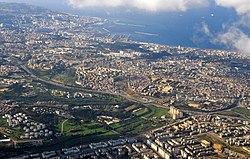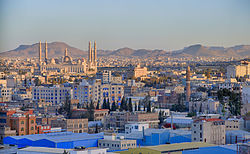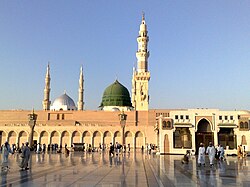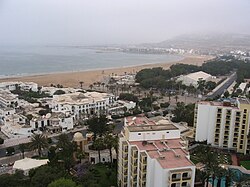Largest cities
Largest cities in the Arab world by population: [2] [3]
| Rank | Country | City | Population | Founding date | Image |
|---|---|---|---|---|---|
| 1 | Cairo | 22,800,000 | 968 CE [4] |  | |
| 2 | Baghdad | 7,800,000 | 762 CE [5] |  | |
| 3 | Riyadh | 7,700,000 | 1746 CE [6] |  | |
| 4 | Khartoum | 7,200,000 | 1824 CE [7] |  | |
| 5 | Amman | 6,847,964 | 7250 BCE [8] [9] |  | |
| 6 | Alexandria | 6,250,000 | 332 BCE [10] |  | |
| 7 | Dubai | 6,050,000 | 1833 CE [11] |  | |
| 8 | Kuwait City | 5,050,000 | 1613 CE [12] |  | |
| 9 | Casablanca | 4,450,000 | 7th century [13] |  | |
| 10 | Algiers | 4,325,000 | 944 CE [14] |  | |
| 11 | | Damascus | 3,975,000 | ~8,000–10,000 BCE [15] |  |
| 12 | Jeddah | 3,950,000 | 522 BCE [16] |  | |
| 13 | Sana'a | 3,275,000 | ~500 BCE (possibly earlier) [17] |  | |
| 14 | Dammam | 2,925,000 | 1923 |  | |
| 15 | Tunis | 2,725,000 | 814 BCE [18] |  | |
| 16 | Mecca | 2,675,000 | 2nd century CE [19] |  | |
| 17 | Doha | 2,650,000 | 1823 CE [20] |  | |
| 18 | Gaza City | 2,275,000 | 15th century BC |  | |
| 19 | Mogadishu | 2,250,000 | 10th Century [21] |  | |
| 20 | Rabat | 2,125,000 | 10th century [22] |  | |
| 21 | | Aleppo | 2,098,210 | ~5,000 BCE [23] |  |
| 22 | Beirut | 1,930,000 | ~3000 BCE (outer estimate) [24] |  | |
| 23 | Tripoli, Libya | 1,870,000 | 7th century BC |  | |
| 24 | Abu Dhabi | 1,850,000 | 1761 CE [25] |  | |
| 25 | Basra | 1,710,000 | 636 AD |  | |
| 26 | Oran | 1,640,000 | AD 944 |  | |
| 27 | Muscat | 1,620,000 | 550 BCE |  | |
| 28 | Manama | 1,560,000 | 1345 or earlier |  | |
| 29 | Mosul | 1,550,000 | ~700 BCE |  | |
| 30 | Medina | 1,530,000 | 9th century BC |  | |
| 31 | Nouakchott | 1,500,000 | 1903 [26] |  | |
| 32 | Tangier | 1,410,000 | 10th century BCE [27] [28] |  | |
| 33 | Hargeisa | 1,401,000 | 1860 [29] [30] [31] |  | |
| 34 | Fez, Morocco | 1,310,000 | 789 |  | |
| 35 | Taiz | 1,276,000 | first half of the 12th century CE [32] |  | |
| 36 | Agadir | 1,270,000 | 12th century |  | |
| 37 | Erbil | 1,220,000 | ~2300 BCE |  | |
| 38 | Kirkuk | 1,160,000 | 2335 BC [33] |  | |
| 39 | Irbid | 1,070,000 | ~3,200 BCE (possibly earlier) |  | |
| 40 | Al Ain | 1,060,000 | 985 CE [34] |  | |
| 41 | Najaf | 1,050,000 | 791 AD [35] |  | |
| 42 | Aden | 1,021,000 | 8th century BC [36] |  | |
| 43 | Mansoura | 993,000 | 1219 |  |